By Dave Wilson
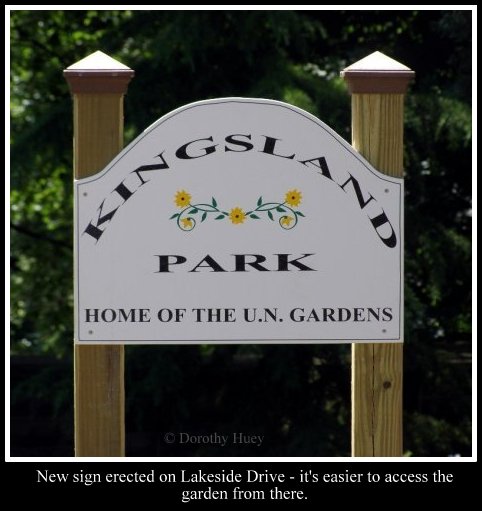
Little more than 100 years ago, the ten-acres now known as Kingsland park was mostly private land, however, following World War 1 and the creation of Memorial Park to honor those who served and died in that war, Nutley's town fathers saw the need to preserve more public space in our town. Here, Dave Wilson who grew up mid-century with the park as his virtual backyard traces the evolution of the wild woods to the beautiful park today.
CREATION OF KINGSLAND PARK
What were Nutley civic groups and elected officials doing in 1921 to enhance the town’s appeal to current and prospective residents? What was being done on a national level to preserve open space and provide recreational opportunities?
We now know that from 1872-1938, the golden era of U.S. National Park authorization, our forefathers forever protected vast areas of land and resources from private development. Nutley was creating our wonderful park belt following the Third River as it flows through the township. These preservation activities ensured no development within the flood plain and provided a multitude of benefits for the public.
Kingsland Park originated in June 1921 with ordinance #35 to create, acquire, layout, improve, and embellish a public park along the easterly shore of Kingsland Lake from Rutgers Place to Kingsland Street. $7,500 was appropriated to purchase five parcels of land from Nutley Realty Co., Emil Schneider, A. Paul Geger, Wilhem B. E. Hirsch, Theodore Zeigler, and Gerardo Cetrulo. This action created the main body of the park.
In August 1930, ordinance #565 provided for the acquisition of certain lands for park purposes either by gift, condemnation, or purchase. Nutley acquired six more parcels for $12,000. These lots made up the area around the baseball field and the right of way for stairs to McKinley St. This ordinance was later amended to include construction of cinder paths, clearing of land, and other such improvements, along with funds for tools and payroll.
Final land acquisition was provided for by ordinance #767 dated November 1935. This included the northwest path from Passaic Avenue and the stairway access from Lakeside Dr. Maude A Maguire was paid $1,500. A grand total of $21,000 was spent to acquire this beautiful park with additional improvements to provide fishing, wading, walking, picnics, weddings, bird watching, sleigh riding, ice skating, baseball, and other outdoor recreational activities.
Three locally quarried brownstone set of stairs leading into the park were constructed under Works Progress Administration grants. These New Deal projects provided public infrastructure improvements and jobs for the unemployed during the great depression of the 1930s. Seven bridges were installed for people and vehicle access.
Playground equipment was installed in the late 1940s among a grove of weeping willows and picnic tables on the island. There were monkey bars, see-saws, swings, a sandbox, sliding board, and carousel for exercise and fun. Modernization occurred over the next several decades as storm damage and safety codes necessitated improvements of the playground. We used to sit on wax paper to make the sliding board really fast and get dizzy on the carousel we pushed as fast as possible.
The lowering of the dam in the 1950s and a new bridge at Passaic & Rutgers in the 1960s was supposed to help alleviate flooding on Passaic Ave. Continued erosion of the river banks inspired some Comprehensive Education & Training Act projects, using old sidewalks and curbs as walls. These walls proved unsightly and prone to failure. Grants, capital ordinances, and DEP permits led to the Gabion rock basket walls that are now used and can be naturalized with plantings.
KINGSLAND PARK as BACKYARD for ROBERT, DAVID, and PALS
A couple saves up money to buy their dream home and raise children. A yard would be nice for swings, pets, and play area, but oh those taxes on a big lot! My parents figured it out: buy a home abutting a park.
Our family lived on Wharton Avenue and then moved to Lakeside Drive, each house a spit-and-a-holler from the park. My brother, our friends and I visited the playground in the 1950s, 1960s and 1970s. Every time one or the other of us fell in the river, which was quite often, our Mom was sure we would drown before age 12. The 1960s was our peak play time in the park but skated and enjoyed other outdoor activities in the 1970s, too.
Kingsland Park was our backyard. This park had everything: a ball field, playground equipment, a “mountain,” streams, waterfalls, trees, and paths for running and biking.
Summer break meant dawn to dusk fun. Recreation program with caroms, baseball and field trips. Fishing in the pond and beneath the waterfalls. Endless hours climbing weeping willow trees that have, alas, succumbed to age and storms. The playground equipment provided exercise and confidence building.
We walked the top of the dam to answer a dare. We had old sneakers for wading and always checked for leeches. Construction in the neighborhood meant cement tubs to “borrow.” With bamboo poles and tubs, our Tom Sawyer river adventure began. The Great Rotary Duck Race happened here. There was space for water powered rockets, balsa wood gliders, badminton, and bike riding lessons with Dad.
We watched many picnics, weddings, celebrations, and concerts from our patio. We even supplied electric for the music sometimes. The First Aid Squad, Nutley Fire Department, schools, families, civic groups, businesses, and churches all used this great park. The Bicentennial Wagon Train camped overnight here in 1976, thanks to Everett Johnesee.
We ice skated from the end of December until March. We even shoveled the snow off the ice. The bonfire was the main attraction for us, as we collected wood and discarded Christmas trees to light up the park and keep warm. Our curfew was ten o’clock and no skating until homework was done.
Many games of chicken over thin ice, manhunt, hockey and speed skating were supported by our winter purchases from Savino’s and Drewes’. Skating socks and hooks to tighten our laces kept us on the moonlit ice for hours.
We normally changed on the “steps to nowhere” at the foot of Howe Ave. and hid our sneakers in the U. N. Garden so no one could take them. During really cold spells we would put our skates on at home and walk right onto the ice behind our home. My brother Robert remembers skating all the way to the Mudhole.
We built snow forts for our snowball battles. The hills at the foot of McKinley Street and Howe Avenue were the sleigh riding spots that fulfilled our need for speed. Flexible Flyers with steel runners were the choice - no sissy saucers or plastic sleds. The big tree at the first turn gave me a concussion and really crunched my sled.
The “mountain” on the east side of the park had trails, small caves that cold air and bats came out of, rope swings, and rocks piled into forts for Army games. On the edge of an old quarry after heavy rains, we could find unusual rocks and items discarded by residents. We became amateur rock hounds and archeologists. There was never a shortage of rocks for skipping on the water. Wow! were we lucky to have this natural area to explore and remember.
CREATION OF THE UNITED NATIONS GARDEN
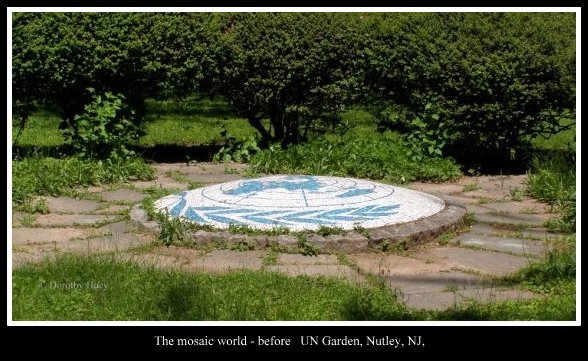
The United Nations is, “an organization to promote international co-operation and to create and maintain international order.” The organization was established in 1945 after World War II in order to prevent another such conflict.
The love of freedom and yearning for peace inspired some Nutleyites to create the first United Nations Garden in the U.S.A. Mrs L.R. Zocca, Gertrude Guenzler, Donald R Hoch, Mrs Paul Witting and Henry Lachenauer presented their idea to the Home Garden Club of Nutley, which unanimously approved it. Carl Orechio, a club member and Nutley Commissioner, found the perfect site in Kingsland Park. The north end by the pond between Howe Ave. & Lakeside Dr. would allow visitors to easily access the garden.
The next step was design, and the club membership included Roy Blair, a Rutgers University trained landscaper, who formulated the layout that was followed without change. Milton Anderson, another club member, had a world-wide knowledge of trees and shrubs. Anderson was the perfect choice to select numerous specimens that would represent various countries from around the world.
Funding ideas came from Ann Troy and Edgar Sergeant. The plan would mirror the one used in the 1920s to raise funds for trees in Memorial Park that honored WW1 veterans. Citizens could buy trees and shrubs that helped perpetuate the memories of loved ones. George Stoothoff was the super salesman who collected 112 memorials that would fund the entire garden.
The center monument contains a wonderful mosaic that represents the countries that comprise the United Nations. The above-mentioned members were assisted by Edward Flammer, Cornelius Schenck, Paul Urban, and Edward Woolf when the weeds and grass had to be tamed around the embryonic flower beds.
The formal dedication of the garden took place in October 1959, with Frank Jannuzl, Mayor Harry W Chenoweth and Carl Orechio making presentations. Alice Lester and Ade Welenowski brought the Girl & Boy Scouts to represent the youth of Nutley. Colors were presented by the Veteran’s Council.
The first tree planted was a Metasequoia, also known as a Dawn Redwood. Metasequoias are thought to be the direct ancestor of California redwoods. This oldest tree known was thought to be extinct until an expedition found some in China in 1948 and brought seeds back for propagation. The specimen planted in the U.N. garden is still thriving nearly six decades later.
The centerpiece dedication occurred in October 1961 and was followed by a stone monument and flag poles in 1962, donated by Edgar Sergeant. Many trees and plaques were added over the next twenty years as the garden reached it pinnacle.
In 2009, local Boy Scout Tyler Huey enlisted friends family, troops, and cub packs to restore the garden. Over the years, storms, vandalism, neglect and the passing of the founders have taken their toll, and the area is only a shell of the glory and ideas that founded it. Perhaps some local group or another Eagle Scout will find inspiration to restore Nutley’s United Nations Garden to its former grandeur.
Author's Note: The UN Garden section was based on the December 1961 Tendril newsletter and press release which documented the creation of this garden. Thanks to Tom Hanlon for sharing the Parks department files with me back in 1978.
Originally published in Nutley Neighbors, September, October and November 2017
Reprinted with permission from Nutley Neighbors, 2017; Best Version Media, A community magazine serving the residents of Nutley, N.J.
UN Garden Drive For Funds Seeks To Reach Everybody in Nutley
Effort Being Made To Make Project In Park Fully Representative
NUTLEY NJ -- APRIL 13, 1961 -- In the campaign for funds for the completion of the UN Garden launched recently by Nutley Chapter of the American Association for the United Nations, an extensive effort will be made to obtain contributions from as many Nutley residents as possible. “This will emphasize,” said Mrs. Louis Zocca, chairman of the current drive, “the community-wide nature of the project and make the UN Garden a symbol of the UN itself – people working together just as nations are struggling to work together in achieving world order.”
This aim has been uppermost in the minds of the UN Garden of Nutley Committee from the beginning.
One hundred and more specimens have been contributed over the past two years by Nutley citizens, many of them using the opportunity to honor some friend or kinsman.
For example, a Chinese dogwood was given in memory of Lt. Charles W. Tillou, who died while on a mission in the Air Force. A European plane tree and a sawleaf Asiatic Zelkova are in the garden to honor the memory of Sgt. Larry Di Vuola, who also died in service.
In memory of Abraham Jaffe, Norway spruces were contributed by a group of his neighbors and an Austrian pine by the Nutley AAUW Chorus.
The Neighborhood Circle of Kingsland Park, a group of residents near Kingsland Park, raised money through card parties and a hat sale to underwrite the Japanese holly hedge surrounding the center of the garden.
A variety of other groups in town also contributed specimens among them Spring Garden Parent-Teacher Association, ITT Laboratories, Nutley Park Shop Rite, Nutley Police Reserves, the employees of the Guarantee Supermarket, St. Paul’s Couples Club, Nutley Elks Auxiliary.
Nutley Girl Scouts are donating two specimens of the newly developed yellow Girl Scout rose which will be set out at an appropriate time.
Nutley Home Garden Club accepted the task of spearheading the project and members of the landscape committee of the garden are all members of this organization.
Theirs has been the task of securing and setting out he specimens in accordance with the landscape map prepared by Roy Blair in consultation with Milton Anderson, landscape specialist, and Lawrence D. Little Jr., Essex County Agricultural Agent.
Their task, too, has been the weeding and general care of the budding garden; even the Boy Scout and Girl Scout organizations have at times helped with these chores. Mr. George Stoothoff, chairman of the UN Garden of Nutley Committee, has led this work, with Miss Ann Troy serving as contributions chairman.
The Home Garden Club of Nutley last year won a prize in contest for its entry, the UN Garden, which was voted one of the ten outstanding projects in the state. The prize of $100 was turned over to the UN Garden.
The garden is quite unique in the United States in its aim to bring together specimens of trees and shrubs from as many member countries of the UN as possible. Some of the specimens have been described in a series of articles by Milton H. Anderson which have appeared from time to time in The Nutley Sun.
Among them is the metasequoia, a dawn redwood, the offspring of seeds taken out of a remote Chinese valley before that country was taken over by the Reds. Some day, it is hoped, this tree will tower in Kingsland Park.
There are also specimens of the temple cedar, a picturesque tree which takes its name from the fact that it is widely utilized in the building of temples in Japan and China.
There is also the ginkgo, representing Nationalized China, whose graceful leaves resemble the maiden hair fern, hence its popular name – maiden hair tree. It bears fig-like fruit and is very resistant to insects and disease.
Among other majestic and beautiful trees of the garden are the English oak, the Lebanese cedars, the Italian poplar, the Japanese cherry, all varieties – which have rich tradition in the history of civilized man.
Among the shrubs, according to Mr. Anderson, are chaste tree, representative of Iran, a long blooming and fragrant bush with unusual leaves, shaped like a maple leaf.
There are also Japanese lilacs which grow into trees distinguished by unusually wide leaves; Korean Azalias, mauve-colored and which bloom long before other varieties. In the garden, too, are specimens of deutzia gracilis, a low growing shrub which in the Spring becomes a mass of beautiful white blossoms. There is also the fragrant snowball, a miniature shrub which gives quantities of bell-like flowers.
All of the specimens in the garden are tagged for easy identification. Later in the Spring, when the weather is favorable and the shrubs begin to bloom, the Home Garden Club will undertake a guided tour of the garden, and other tours will be arranged.
The funds which are being sought in the current drive of the American Association for the United Nations will be utilized for the completion of the garden. The center area will include a six-foot Venetian glass mosaic replica of the UN emblem, designed by Rolf Myller of New York and executed by the House of Rambusch, New York specialists in decorative crafts. The American Association for the United Nations has pledged to contribute the mosaic, which will cost $1,000. An additional $1,500 will be needed to provide the foundation and the hexagonal cobblestone area which will surround the centerpiece.
The AAUN Garden finance committee consists of Mayor Harry W. Chenoweth, Carl A. Orechio, Charles A. Roepell, Edward J. Savage, Miss Ann Troy, Mr. and Mrs. W. L. Wedemeyer, Mrs. Stanley C. Yorton, Dr. Louis R. Zocca, and Mrs. Zocca, who is serving as chairman.
Contributions may be made to UN Garden – AAUN, Care of Mrs. Louis Zocca ... Nutley.
The Nutley Sun/ April 13, 1961
UN Garden Restoration, Nutley, NJ 2009 - Eagle Scout Project by Tyler Huey
By Anthony Buccino
When the Nutley Chapter of the American Association for the United Nations sought to create “a symbol of the UN itself – people working together just as nations are struggling to work together in achieving world order”, citizens and groups rallied to meet fundraising efforts and bring the garden to reality in 1962.
Located in the north section of Kingsland Park, between a split in the Third River, the UN Garden peninsula points across what is called both Yantacaw Pond and Kingsland Pond to the dam at Kingsland Manor.
With help from the Nutley Home Garden Club, the Nutley AAUW Chorus, and Boy and Girl Scout organizations, nearly 60 trees plus shrubs and flowers were planted in the Kingsland Park peninsula. The trees represent the many nation members of the United Nations.
A six-foot Venetian glass mosaic replica of the UN emblem was created as an anchor to the site. Visitors are greeted at the entrance to the peninsula area by UNITED NATIONS GARDEN 1962 MARKER GIVEN BY EDGAR SERGEANT.
According to an article entitled UN Garden Drive For Funds Seeks To Reach Everybody in Nutley, published in The Nutley Sun on April 13, 1961, one hundred and more specimens were contributed by Nutley citizens, many of them using the opportunity to honor some friend or kinsman.
The paper noted that the garden is quite unique in the United States in its aim to bring together specimens of trees and shrubs from as many member countries of the UN as possible.
The 10-acre Kingsland Park has large, open spaces favored for picnics, handicap accessible playground area, a baseball field, field house, walking/bike track, and a gazebo donated by Nutley Rotary.
But the years have not been kind to the United Nations Gardens in Kingsland Park, Nutley
As the various garden support groups faded over the next four decades, maintenance was left largely to a few overwhelmed gardeners and the town’s parks department. By 2008, the UN Garden had fallen into neglect as the groups that strongly supported it in its heyday nearly five decades earlier dwindled.
Resident and Boy Scout Tyler Huey noted, “Nutley’s U.N. Garden is the first of its kind in our area but it is in bad shape.”
The teen, then a member of Troop 142 at Vincent Methodist Church, proposed as his Eagle Scout project to Nutley Parks and Recreation Superintendent Thomas A. Pandolfi, “cleaning the existing mosaic tiles in the world globe mosaic in the center of the park, as well as replacing the missing tiles, reestablishing the paths leading to the globe, trimming the hedges around the globe so they are not over grown an out of shape, and picking up trash in both the surrounding rivers and island.
“I will also identify trees with help from John Linson, the Nutley forester, and place markers on them, plant a butterfly garden near the front of the park, plant new trees and remove dead ones, and place a sign showing the layout of the park.
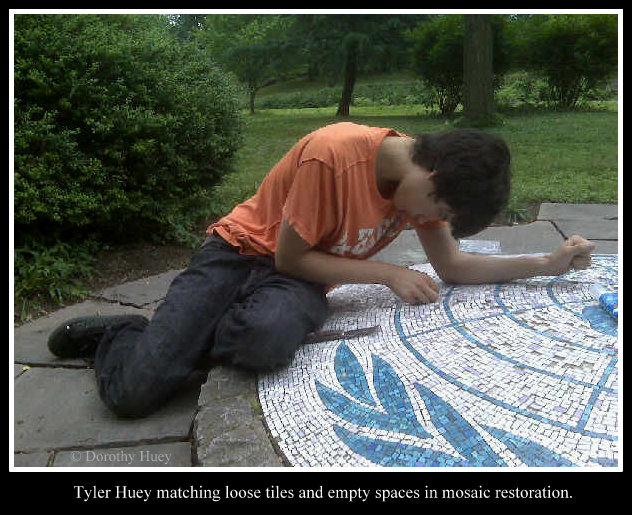
“I will work on the mosaic globe with Patty Vangieri of the Glass Gallery in Nutley, who is a professional glass and mosaic artist. She will help me refurbish the globe, free of charge, because of her passion and belief in this project.”
Huey stated in his November 2008 proposal to the township, that the Nutley Community Preservation Partnership, citizens and the community of Nutley would benefit from the project.
“Overall, my goal is to restore the garden to its former glory, mirroring as closely as possible its original plan, and to reunite the community with the garden and raise its profile throughout the area. I envision the garden as a showcase for the township.”
When all the T’s were crossed and all the I’s dotted, Huey implemented his his main goals: to first clean up the arena using the help of my troop, Cub Scout packs, and family members. The cleanup and tree identification began in spring 2009, with all the restoration and upkeep lasting about five months finishing in time for park’s fiftieth anniversary. The mosaic globe restoration was expected to be complete in summer 2009.
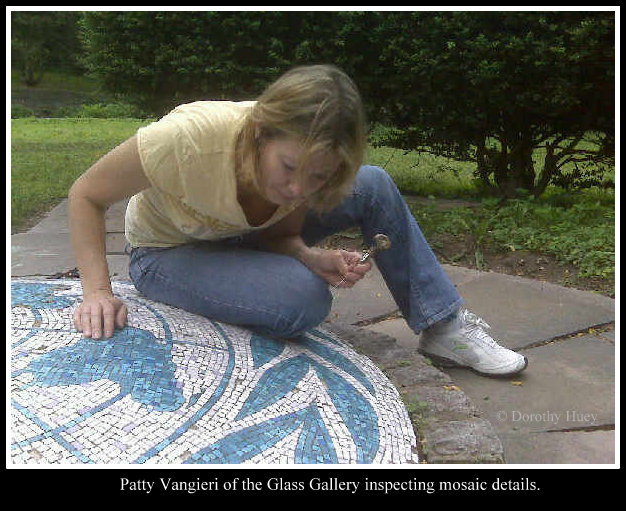
n June 2009, Huey told Meghan Grant of the Nutley Sun, “I was thinking about doing an ecological project.”
Huey told the paper one of his goals was to rid the area of invasive species of plants that invaded the garden “to bring the garden back to its former glory.”
Grant wrote that Parks and Recreation Commission Mauro Tucci granted the team permission to place temporary tags on the remaining trees to distinguish their species, and that permanent markers would be installed by the town, and all of the specimens in the garden were tagged for easy identification.
(Some aspects of the project were not approved at the time: removing and replacing dead trees, restoring garden paths, creating a sign showing the layout of the park and planting a butterfly garden. Also, permanent tree markers have not yet been installed.)
A team clean-up was held on Saturday, June 27, 2009. With help from the NCPP, friends, family, experts, novices, packs and troops, Huey accomplished his main project to identify the trees with temporary tags, and to fix the mosaic globe. And the byways were cleaned up as well due to the extended Earth Day effort.
Commissioner Tucci visited the volunteers. He said he will be writing letters to all the countries that donated trees when the garden was established in 1962. Many thanks to Tucci and Nutley Department of Parks and Recreation, for removing the piles of trash collected, as well as providing power for trimming bushes. Also thanks to the late Nancy Gruelich and Joe Colucci for their support and encouragement.
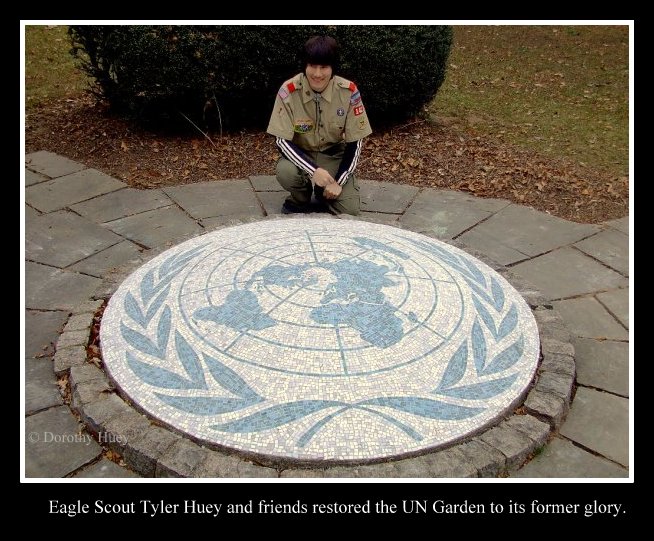
UPDATE: In the past eight years, the river has accumulated deleterious debris. The long-lasting effects of hurricanes Sandy and Irene, not to mention other heavy storms that bring runoff and other debris down river from upriver, haven't made maintaining a garden any easier. The bushes, flowers and such sure could use more loving gardeners’ hands once again.
